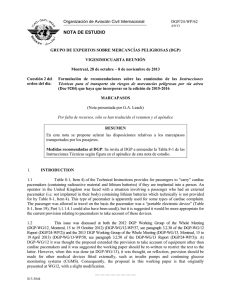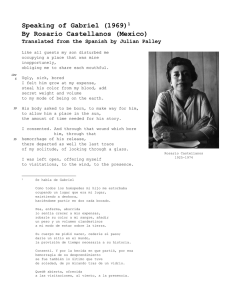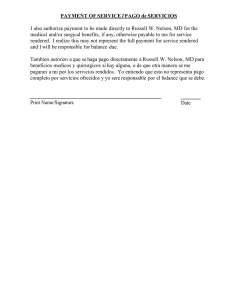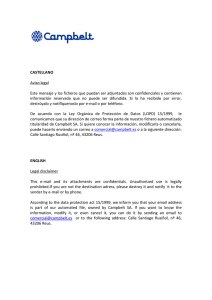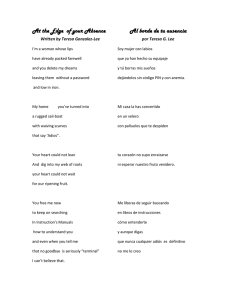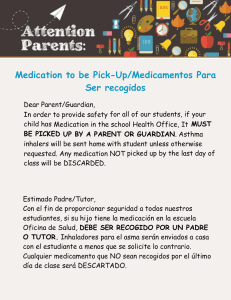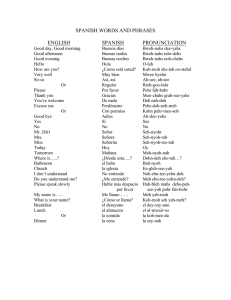nota de estudio
Anuncio
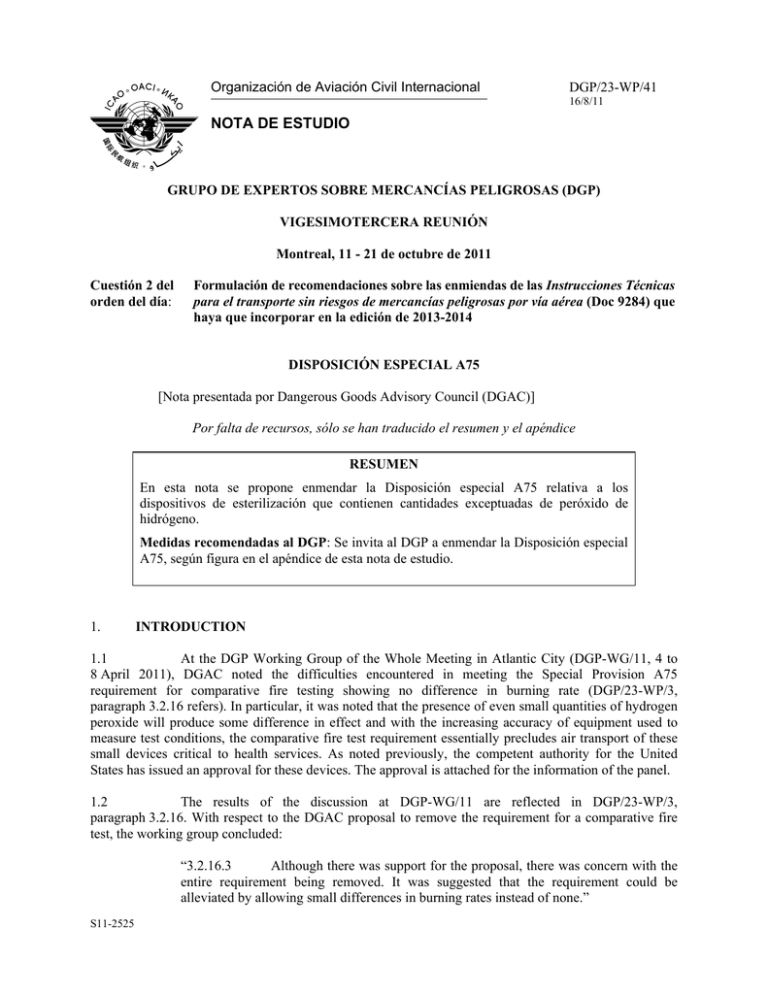
Organización de Aviación Civil Internacional DGP/23-WP/41 16/8/11 NOTA DE ESTUDIO GRUPO DE EXPERTOS SOBRE MERCANCÍAS PELIGROSAS (DGP) VIGESIMOTERCERA REUNIÓN Montreal, 11 - 21 de octubre de 2011 Cuestión 2 del orden del día: Formulación de recomendaciones sobre las enmiendas de las Instrucciones Técnicas para el transporte sin riesgos de mercancías peligrosas por vía aérea (Doc 9284) que haya que incorporar en la edición de 2013-2014 DISPOSICIÓN ESPECIAL A75 [Nota presentada por Dangerous Goods Advisory Council (DGAC)] Por falta de recursos, sólo se han traducido el resumen y el apéndice RESUMEN En esta nota se propone enmendar la Disposición especial A75 relativa a los dispositivos de esterilización que contienen cantidades exceptuadas de peróxido de hidrógeno. Medidas recomendadas al DGP: Se invita al DGP a enmendar la Disposición especial A75, según figura en el apéndice de esta nota de estudio. 1. INTRODUCTION 1.1 At the DGP Working Group of the Whole Meeting in Atlantic City (DGP-WG/11, 4 to 8 April 2011), DGAC noted the difficulties encountered in meeting the Special Provision A75 requirement for comparative fire testing showing no difference in burning rate (DGP/23-WP/3, paragraph 3.2.16 refers). In particular, it was noted that the presence of even small quantities of hydrogen peroxide will produce some difference in effect and with the increasing accuracy of equipment used to measure test conditions, the comparative fire test requirement essentially precludes air transport of these small devices critical to health services. As noted previously, the competent authority for the United States has issued an approval for these devices. The approval is attached for the information of the panel. 1.2 The results of the discussion at DGP-WG/11 are reflected in DGP/23-WP/3, paragraph 3.2.16. With respect to the DGAC proposal to remove the requirement for a comparative fire test, the working group concluded: “3.2.16.3 Although there was support for the proposal, there was concern with the entire requirement being removed. It was suggested that the requirement could be alleviated by allowing small differences in burning rates instead of none.” S11-2525 DGP/23-WP/41 -2- 1.3 In carrying out the comparative testing for the above referenced approval, the tested packagings contained four inner packagings containing 29.6 ml each of 59% hydrogen peroxide. As such, the tested package closely matched the limits allowed by Special Provision A75 limits. While many measurements taken in conducting comparative fire tests may vary depending on test conditions, comparing the maximum temperature inside packages while burning should provide a reliable basis for evaluating the potential increased fire severity. In the case of the comparative fire testing conducted, the maximum temperature measured inside the package containing the hydrogen peroxide was 900oC whereas the maximum temperature inside the same package using water was 710oC. DGAC considers that the fire tests done in relation to the United States approval validate the level of safety provided by the excepted quantity package provisions and quantity limits in A75 and that the results suggest that the Special Provision A75 comparative fire test requirement is unnecessary. Nevertheless, in view of the working group’s comments, DGAC proposes revision of Special Provision A75 fire test criteria to permit an increased temperature due to the presence of hydrogen peroxide of 250oC. 1.4 With respect to the above United States approval, DGAC notes that it permits small openings in packagings to allow for the slow escape of gas over the life of the packaging. Based on data available, for the 29.6 ml of hydrogen peroxide per inner packaging described in the approval, at a temperature of 40oC, the amount of oxygen gas released due to decomposition would be approximately 0.02 mL per minute — an imperceptible amount quickly dispersed by an aircraft ventilation system. DGAC proposes that provision also be made for such safe release in the special provision. ———————— DGP/23-WP/41 Apéndice APÉNDICE Parte 3 LISTA DE MERCANCÍAS PELIGROSAS, DISPOSICIONES ESPECIALES Y CANTIDADES LIMITADAS Y EXCEPTUADAS ... Capítulo 3 DISPOSICIONES ESPECIALES ... Tabla 3-2. IT A75 Disposiciones especiales ONU Los objetos tales como dispositivos de esterilización con un contenido inferior a 30 mL por embalaje interior y no más de 150 mL por embalaje exterior pueden transportarse en aeronaves de pasajeros y de carga de conformidad con las disposiciones de 3;5 sin tener en cuenta el valor de la columna 9 ni la indicación “Prohibido” en las columnas 10 a 13 de la Lista de mercancías peligrosas (Tabla 3 1), siempre que dichos embalajes se hayan sometido en primer lugar a una prueba de incendio comparada. Esta La prueba de incendio comparada debe demostrar que no hay diferencia entre la velocidad de combustión del el bulto preparado para el transporte (con la sustancia que se ha de transportar) y un bulto idéntico lleno de agua debe demostrar que la temperatura máxima medida dentro de los bultos durante la prueba no difiere en más de 250ºC. Los embalajes pueden incluir sistema de ventilación para permitir que el gas producido por la descomposición gradual se libere lentamente. ... — FIN —
